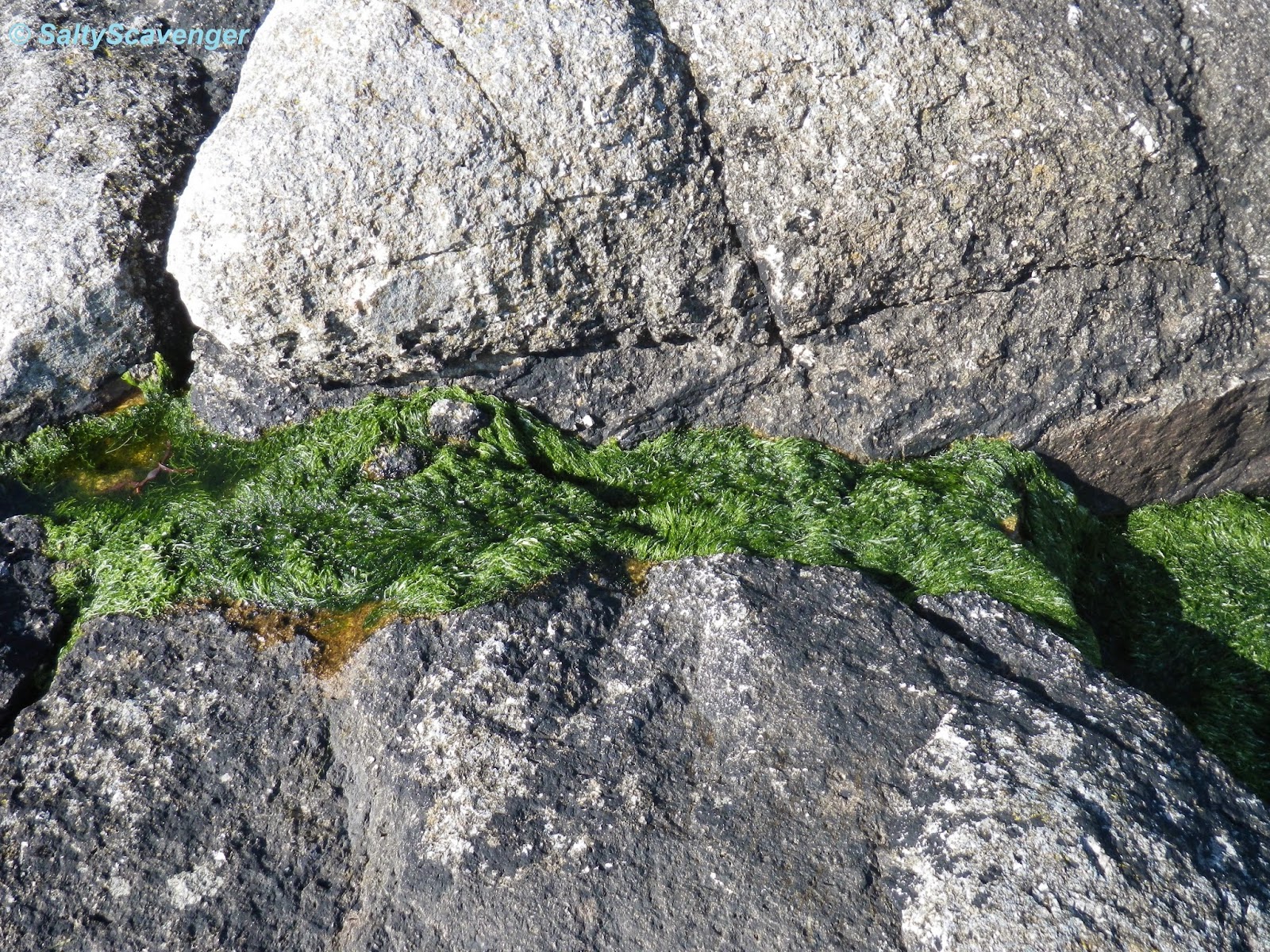The shore
comprises outcrops of bedrock and boulders amongst vast expanses of sandon the
lower shore.
Fucoids form
a blanket across the rock, with dense ephemeral green alga and the occasional
fucoid on the small cobbles toward the edges of the outcrops.
Periwinkles,
limpets and topshells occur across the outcrop with anemones, crabs, spirorbid
polychaetes and red seaweeds beneath the fucoid understorey.
Habitat
classification:
|
Substrate
|
LR (Littoral rock)
|
LS (Littoral substrate)
|
|
Habitat
|
LLR (Low energy littoral rock)
|
FLR (Features of littoral rock)
|
LS.LSa (Littoral sand)
|
|
Biotope complex
|
LR.LLR.F (Fucoids on sheltered marine shores)
|
Eph.FLR.Eph (Ephemeral green or red seaweed communities
|
Rkp (Rockpools)
|
|
|
|
LR.MLR.BF.Fser.Bo (Fucus serratus
and under boulder fauna on lower eulittoral boulders).
|
LR.LLR.F.Asc .FS (Ascophyllum nodosum
on full salinity rock)
|
LR.LLR.F.Fserr (Fucus serratus on
sheltered lower eulittoral rock).
|
|
|
|
Below are images of organisms you may encounter whilst rockpooling in this habitat:
 |
| The rocky shore is comprised of outcropping bedrock and boulders covered
by fucoids and ephemeral green alga. Habitat classification: LR.LLR.F (Fucoids
on sheltered marine shores) and LS.LSa (Littoral sand). |
 |
Rough periwinkles (Littorina saxatilis) occur on the higher rock of the outcrop.
|
.jpg) |
| Bladder wrack (Fucus vesiculosus)
characterises the mid shore, whilst a mix of seaweeds can be found in
rockpools. Habitat classification: LR.LLR.F (Fucoids on sheltered marine
shores) and LR.FLR.Rkp (Rockpools). |
 |
| Lower down Limpests (Patella
vulgata) and Egg wrack (Ascophyllum
nodosum) with its epiphyte
Polysiphonia sp occur. |
 |
| Eventually the Egg wrack (Ascophyllum
nodosum) and occasional serrated wrack (Fucus
serratus) comes to cover the rocks. Habitat classification: LR.LLR.F.Asc .FS (Ascophyllum nodosum on full salinity rock) |
 |
| Carefully lifting the seaweed reveals the understorey community of red
seaweeds, anemones, gastropods, crustaceans, spirorbid polychaetes and
encrusting epifauna. |
 |
| An understorey red seaweed. |
 |
| An understorey red seaweed. |
 |
| Corallinaceae crusts cover much of the understorey rock. |
 |
Breadcrumb
sponge (Halichondria (Halichondria)
panicea).
|
 |
| Further down serrated wrack (Fucus
serratus) comes to dominate. Here the young growth of f. serratus amongst the understorey reds can be seen. Habitat
classification: LR.LLR.F.Fserr (Fucus serratus on sheltered lower
eulittoral rock). |
 |
Serrated
wrack (Fucus serratus).
|
Amongst the F. serratus and beneath the boulders is a
rich faunal community, comprising an increased number of filter feeding
species. Habitat classification:
LR.MLR.BF.Fser.Bo (Fucus serratus and
under boulder fauna on lower eulittoral boulders).
 |
| A Montagu's crab (Xantho
hydrophilus) amongst seaweed and boulders of the lower shore. |
 |
An anemone
and painted topshell (Calliostoma
zizyphinum)
|
 |
A seaspider
carrying its eggs.
|
 |
A seaspider
carrying its eggs.
|
 |
A
Broad-clawed porcelain crab (Porcellana
platycheles) on the underside of a boulder of the lower shore.
|
 |
| A wart barnacle (Verruca stroemia)
on the underside of a boulder on the lower shore. |
 |
| Encrusting epifauna, spirorbid polychaetes and wart barnacles (Verruca stroemia) on the underside of a
boulder on the lower shore. |
 |
| Encrusting epifauna, including spirorbid polychaetes and bryozoa, on the
underside of a boulder on the lower shore. |
 |
An anemone on
the side of a boulder on the lower shore.
|
 |
| A capitellid polychaete. |
 |
| Ephemeral green algae and brown seaweed grow on the mixed substrate
surrounding the outcrop |
 |
| At the low water mark, Thong weed (Himanthalia
elongata) and red seaweeds come to dominate. |
 |
| Boulders at the low tide mark are colonised by a variety of seaweed species including Serrated wrack (Fucus serratus), Chondus crispus , Osmoundea sp, Thong weed (Himanthalia elongata), Lomentaria articulata and sandbinder (Rhodothamniella floridula) |
 |
| A red seaweed |
 |
Red seaweeds
including,Chondus crispus and Ulva sp.
|
 |
| Serrated wrack (Fucus serratus),
Chondus crispus , Osmoundea sp and sandbinder (Rhodothamniella floridula) |
 |
| Osmoundea sp |
 |
| Lomentaria articulata |
.jpg) |
Harpoon weed
(Asparagopsis armata)
|
 |
| A close up of the epiphytic filamentous brown seaweed shows its fine
frond structure. |
 |
| Ceranium sp. |
 |
| Ceranium sp |
 |
| Creep horn (Chondracanthus acicularis) |
 |
| A snakelocks anemone (Anemonia
viridis) |
 |
| Anemone |
.JPG) |
| Away from the rocky shore outcrop great swaths of sand extend across the
bay. Lugworm characterise areas of this sand habitat with their presence
inferred from their casts. |
.JPG) |
| Sand mason tubes also occur throughout the lower shore sand habitat. |
 |
| Netted dog whelks (Nassarius
reticulatus) aggregate to feed on the remains of a green shore crab (Carcinus maenas). |
 |
| The Netted dog whelk (Nassarius
reticulatus) uses its siphon to ‘sniff’ out food. |
 |
| A necklace shell |
 |
| A necklace shell |
 |
Majiidae crab washed up on the shore.
|

























.jpg)







.JPG)
.JPG)






.jpg)



























